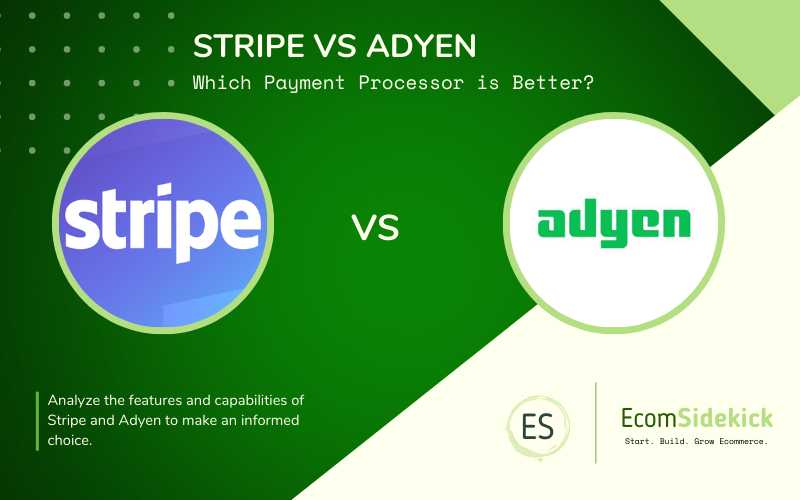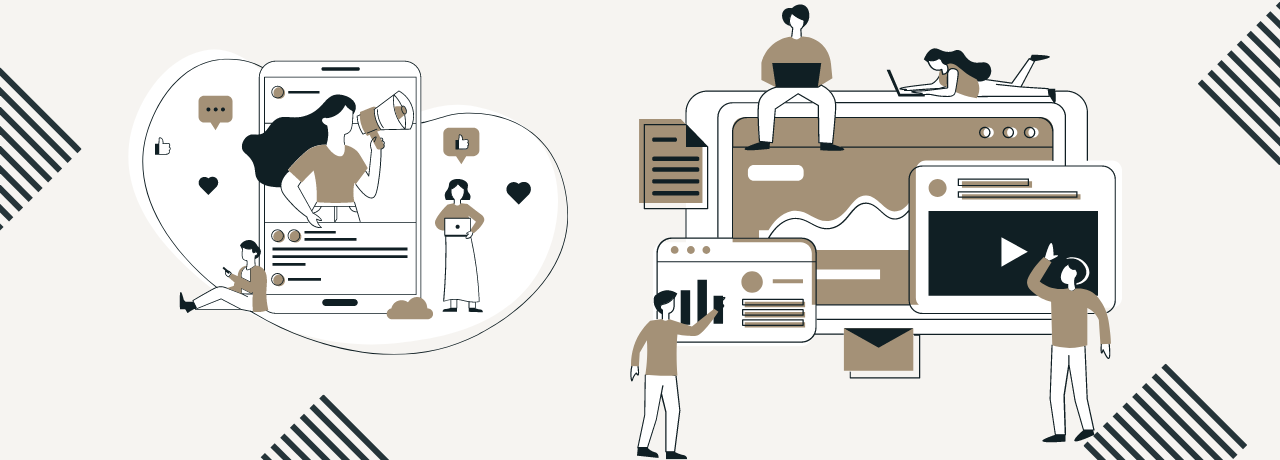Regardless of size, setting up an easy means of collecting payment is a crucial part of being a business owner. Full-stack payment processors like Stripe and Adyen make business transactions seamless and safe.
They also make starting a business much easier. Besides the fact that it improves customer experience, business efforts can be employed in more productive activities.
Stripe vs Adyen these two are popular and reputable payment processing companies today. It is safe to say these are two of the best payment processors available in terms of security, integration, multiple payment methods, pricing, and more.

The problem both seek to solve is summarized into seamlessly aiding end-to-end payments between customers and businesses. Interestingly, there are no setup fees.
Now, which of the two is best? In this article, we will explore and analyze Stripe vs. Adyen in terms of differences, similarities, strengths, and weaknesses.
About Stripe
Stripe came into the scene in 2010 and has taken the world by storm. With its advanced payment tech and infrastructure, it did not take long to have business owners longing for its services. For reasons ranging from extensive integrations, customization, predictable charges, and industry-leading security, among other things, Stripe is today one of the most trusted payment solutions. Today, its services are available in 47 countries, and they accept payments in over 135 currencies.
Unlike Adyen, Stripe does not charge monthly subscription payments but adopts a per-transaction pricing model. Stripes take a 2.9% cut and a $0.3 charge on each transaction for online businesses. On the other hand, in-person payments attract lower fees of 2.7% and $0.05 on each payment. Also, expect to pay an extra 1% on international transactions or any requiring Dynamic Currency Conversion (DCC).
Stripe offers a payout after two business days; however, it considers business emergencies requiring quick funding. Therefore, with its “Instant Payout” option, you can access your funds in as little as 30 minutes. This swiftness comes at a cost, though. You are liable to pay 1% of the total sum you wish to receive and a $0.5 fee per transaction. Remember that the above is the US standard; charges for international customers vary according to country/region.

We recommend this payment platform for startups and small to mid businesses outside the high-risk industry. That said, if you do not want to go through the underwriting processes of opening a merchant account, Stripe is your go-to option. As a merchant aggregator, the payment processor collects payments on behalf of the enterprise and then transfers the sum into the business bank account later. Thus, you do not require an individual merchant account.
Features
- Multi-currency support
- Accepts ACH credit
- Self service onboarding (easy to set up)
- Supports global payments
- Provides hardware tools like terminals and card readers for physical stores
- Does not charge monthly fees
- Interchange plus pricing model.
Pros
Allows for customization
Industry-leading security measures
Supports other payment services like Google Pay and Apple Pay
Easy-to-use developer tools
No early closure fees.
CONS
Limited support for in-person payment issues
Does not integrate with PayPal.
About Adyen
Adyen set out on a mission to overhaul the dilapidated patchwork structures in existence in the pre-2010 years. In 2006, the company began operations in the capital city of Netherlands – Amsterdam. By 2012, the business had spread to Paris, San Francisco, Stockholm, and London.
Though its main market is Europe, Adyen is today fully functional in Australia, Canada, and Singapore. It also offers limited services in select African countries, including Egypt, Morocco, Nigeria, and South Africa. Adyen currently accepts payments in multiple currencies (37), and its services are available in only 30 countries.
It is worth noting that Adyen is a payment processor as much as a merchant account provider. By implication, business owners who choose this payment service provider will spend a long time getting operations approval. The registration process is more thorough due to the payment processor’s advanced features.

Some of these are risk management, revenue protection/optimization, real-time reporting, and more. It goes without saying that it is a more appropriate payment solution for mid to large businesses with high transaction volumes. Business owners who like to have a merchant account will find this payment processor especially helpful.
The payment service provider adopts the interchange ++ model, which charges the standard interchange fee plus a processing fee and a payment method fee. European businesses enjoy a standard fee of 0.3% – 0.4%, while US customers attract up to 3%. Transaction fees are a flat rate of €0.10 and a “payment method fee” between €0.35 and 6%.
Bear in mind that the payment method fee varies greatly. Find more information about Adyen pricing here. What’s more, with her API-centered approach, Stripe billing is adequately suited to working with several billing arrangements and, by extension, accepting payments.
Features
- Supports a wide range of payment methods, including Apple Pay and Google Pay
- Does not charge integration fees
- Wide and easy integration
- Requires opening a merchant account
- Tracks payment flow and provides customer insights to business owners.
Pros
Best for large businesses
Provides a dedicated merchant account for businesses
Accepts payments via PayPal
No monthly, early termination, or setup fee
Excellent customer service.
CONS
Longer registration and approval time
Not recommended for businesses with low transaction volume.
Similarities Between Stripe vs Adyen
Extensive Integrations

Without mincing words, both Stripe and Adyen have a long list of partners, including BigCommerce, Oracle, Shopify, and Zoho. Also, both payment processors provide quite a robust and advanced infrastructure that easily integrates with your business website and app to receive mobile payments. One of the coolest features includes their provision for one-click recurring payments and ACH direct debit.
Accept Payments in Local and International Currencies
Both Stripe and Adyen have been in operation for at least a decade and have experienced phenomenal growth. One most notable growth is that they are available in multiple countries, processing payments in multiple currencies and even international cards. Stripe, for one, supports over 130 currencies across 47 countries. Adyen, on the other hand, accepts 30 currencies and currently operates in more than 35 countries.
In-Person Payments
The two payment service providers do not limit their services to online payments. You can request POS systems for electronic payments (debit cards and credit card payments) in your physical store. Adyen enlisted Slice in 2021 to build its POS machines, which became great news for brick-and-mortar businesses.
Similarly, Stripe has the “Terminal” (POS system). These provisions provide customers to choose from a wide range of local payment methods and even contactless payments.
High-Level Security
The two payment gateway providers hold concerns of customer security in the highest regard. Since the launch of both companies, there has been no record of a significant or successful security breach.
Stripe holds a PCI Service Provider Level 1 certification, the highest attainable PCI security certificate. Also, all data is protected under AES-256-bit encryption. Adyen’s fraud prevention strategy through RevenueProtect is by far one of the best.
Differences Between Stripe vs Adyen
Registration Process
This is perhaps the most significant difference between both payment processing companies. Stripe allows for a faster and easier signup process requiring no paperwork, underwriting, or filling long forms. In all, registration should not take more than 15 minutes. In fact, you can access the Stripe Virtual Card in another 30 minutes.
A few days after application, you and your team or employees can get the Stripe Corporate Card with your company logo. On the other hand, getting started with Adyen is more of a rigorous process. Adyen is a merchant account provider; therefore, you will be required to create one. Also, you will need to provide proof of identity of the account opener and shareholders with a minimum of 25% stake in the business.
Pricing Scheme
Stripe adopts an interchange plus pricing, unlike Adyen, which opts for the interchange ++. The former only takes the standard charge plus the acquirer fee, while the latter adds the payment method fee.
Adyen is almost totally free of fees. The only fee aside from the standard fee is the “card scheme fee.” On Stripe, however, you may incur some fees using Stripe depending on the integrations you adopt. However, Adyen has a monthly minimum invoice threshold depending on your type of business. If not met, your business may incur a deficit. In other words, Adyen expects your business to have a specific number of transactions.
Our Pick
Stripe |
| |
Adyen |
|
In a final showdown between Adyen and Stripe, there will be no victor as both have their strengths and weaknesses. It is indeed a difficult call comparing Stripe to Adyen, given that both payment service providers are appropriate for different businesses. However, we will be tempted to favor Stripe over Adyen because of its simplicity and flexibility.
Additionally, in terms of features, customization, and worldwide reach, Adyen is no match for Stripe. But when it comes down to customer service and value-added services, Adyen comes first.
Final Thoughts
Which option is best when comparing Stripe vs Adyen will depend on your customer needs and preferred payment option. Though both help collect payments generally, they vary much in terms of supported currencies and payment methods. Stripe stands out for its security and efficiency in online transactions, providing seamless integration and broad global coverage. It’s undoubtedly the winner in payment processing.
Frequently Asked Questions
What Is Stripe, and How Does It Compare to Adyen?
Stripe and Adyen are both prominent payment processing platforms, but they offer different features and target different audiences. Stripe is known for its developer-friendly interface and ease of integration, making it popular among startups and smaller businesses. Adyen, on the other hand, is a global payment platform that caters to larger enterprises and multinational businesses with extensive payment needs.
Which Platform Is More Suitable for Smaller Businesses or Startups With Limited Technical Expertise?
Stripe is often preferred by smaller businesses and startups due to its user-friendly API and straightforward integration process. It requires minimal technical expertise, making it accessible to a broader audience.
How Do the Costs and Fee Structures Differ Between Stripe and Adyen?
Both Stripe and Adyen have transparent pricing models, but their fee structures may vary based on the specific features and payment methods used. It’s essential to compare transaction rates, setup fees, and any additional costs to determine which platform is more cost-effective for your business.
Can Both Platforms Handle International Transactions and Support Multiple Currencies?
Yes, both Stripe and Adyen are designed to handle international transactions and support a wide range of currencies. Adyen, in particular, is known for its global payment processing capabilities.
What Level of Security and Data Protection Measures Do Stripe and Adyen Offer?
Both platforms prioritize security and adhere to industry-standard security practices, such as PCI DSS compliance, to protect sensitive payment data and ensure secure transactions.
Paul Martinez is the founder of EcomSidekick.com. He is an expert in the areas of finance, real estate, eCommerce, traffic and conversion.
Join him on EcomSidekick.com to learn how to improve your financial life and excel in these areas. Before starting this media site, Paul built from scratch and managed two multi-million dollar companies. One in the real estate sector and one in the eCommerce sector.



